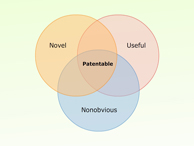Legal Issues in Information Security
Intellectual Property Rights
Think about answers to the following questions and then click each question to reveal its answer. Next, click the ACTIVITY button to attempt an exercise related to intellectual property.
- What are trademarks and copyrights?
- What is a patent? What rights does a patent grant?
- What is the main difference between patents and trade secrets?



- Title
- Title II
- Title III
- Title IV
- Title V
Patent
A patent is associated with inventions, such as machines, processes, and designs, that are deemed useful and new.
In the United States, patents are granted for 17 years, and in some countries, particularly Japan, the duration is 20 years.

Copyright
A copyright applies to expressive works, such as art, music, videos, books, photography, and computer programs.
A copyright lasts for the length of the creator's life plus 70 years after the creator's death.

This situation is a perfect example of intellectual property infringement. This situation could have been avoided had Innovative Design already obtained a patent on the design. Review the following information to learn about the importance of protecting intellectual property.

Innovative ideas are essential for the success of any organization. Improvements in computer and communications networks offer intellectual-property owners new ways to create, share, and sell their property, which may lead to the threat of piracy. Therefore, understanding the opportunities provided by a computer and communications network and its impact on the intellectual property is essential.
Being aware of the intellectual property system empowers organizations to profit from their innovative creations. Intellectual property registration not only protects ownership but also provides exclusive legal rights to the owner to use the product to its maximum commercial potential.
In this section, you will have an opportunity to practice the concepts and processes that you have explored in this lesson.
The Hands-On Lab provides you with an engaging learning experience that is diagnostic and flexible. Following the instructions provided in the Lab Manual, you will be able to practice the steps IT Security Specialists perform on a daily basis and develop the skills required for effective execution and management of IT Security operations.
In this section, you will have an opportunity to apply what you've learned in this lesson in the context of analyzing a business situation. Although simplified, a problem scenario provided here depicts the challenges often faced by professionals in the workplace.
In this interactive case study, you will explore a business situation, review critical information related to the problem discussed in the case, decide on the course of action, and receive a decision analysis summary that discusses the implications of your decision. Once you analyze the impact of your decision, explore alternative solutions to learn about other potential ways to address the issue in the case. Complete your work on the case by submitting the graded assignment that will reflect on your process of analyzing the business situation and defining an appropriate course of action.
After you have gone through the challenge, navigate to Contributing Factors from the panel at the top of your screen.
Congratulations on the success of your song—everyone is so happy for you! Unfortunately, although we all felt you would generate significant revenue, your composition has been illegally distributed among a large audience of music lovers and the expected revenue projections won't be achieved.
Many people use peer-to-peer (P2P) networks—a form of social networking—to share MP3 music. It might or might not be possible to take legal action against the P2P host, but it's worth a try. To begin, please research and describe specific intellectual property laws that were violated and propose remedies the law provides for the listed violations.
Regards,
Robin
Sales Manager
Review Critical Considerations
Select the icons from the top to receive additional
information related to the situation
Tasks
- Discuss the issue with the sales manager.
- Consider all the factors that contribute to the challenge.
- Identify the intellectual property laws that were violated.
- List the specific rights that were violated.
- Identify remedies for the listed violations.
- Write your final recommendations.
- Conduct a self-review of the summary with respect to the evaluation criteria mentioned in the assignment requirements.
- Submit the assignment to the instructor.










